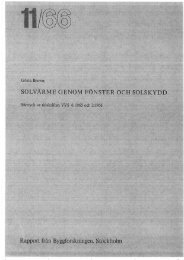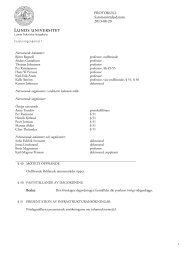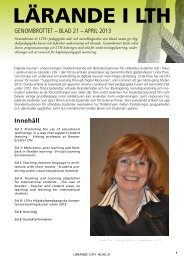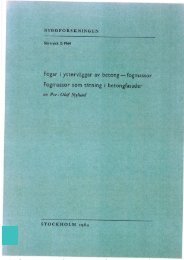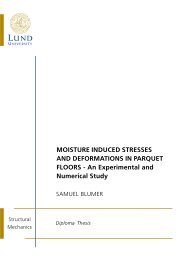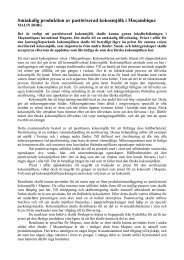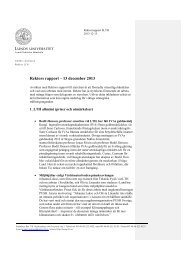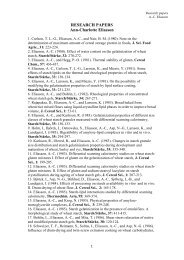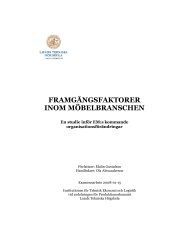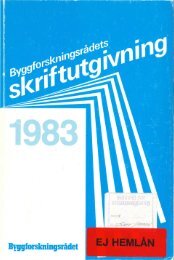User Experience Design at Sony Ericsson - Introducing the Virtual Pet
User Experience Design at Sony Ericsson - Introducing the Virtual Pet
User Experience Design at Sony Ericsson - Introducing the Virtual Pet
You also want an ePaper? Increase the reach of your titles
YUMPU automatically turns print PDFs into web optimized ePapers that Google loves.
Hassenzahl et al – Engineering Joy<br />
Hassenzahl et al (2001) acknowledge semantic differential as a well-known and established technique for<br />
measuring how people perceive and evalu<strong>at</strong>e objects, but point out th<strong>at</strong> <strong>the</strong> differentials general applicability also<br />
is one of <strong>the</strong>ir major disadvantages. As subjects merely r<strong>at</strong>e a scale, no inform<strong>at</strong>ion on <strong>the</strong> underlying reasons for<br />
subjects’ choices is g<strong>at</strong>hered, and <strong>the</strong>refore <strong>the</strong>se remain unknown. Hassenzahl et al suggest <strong>the</strong> repertory grid<br />
technique, as a possible solution to this problem.<br />
Repertory Grid Technique<br />
The basis of this method is th<strong>at</strong> individuals perceive and evalu<strong>at</strong>e <strong>the</strong> world through personal constructs of<br />
similarity-dissimilarity dimensions. These constructs are assessed in <strong>the</strong> first part of an RGT sessions, where a<br />
random triad of products (e.g. mobile phones) is presented to participants who are asked to indic<strong>at</strong>e in wh<strong>at</strong><br />
respect two of <strong>the</strong> three products are similar to each o<strong>the</strong>r and different from <strong>the</strong> third. The construct is named<br />
(e.g. flashy-minimalistic) and participants express which pole <strong>the</strong>y prefer. This procedure is repe<strong>at</strong>ed until no more<br />
personal constructs can be assessed, resulting in a semantic differential where poles have been defined by<br />
participants r<strong>at</strong>her than a practitioner. In <strong>the</strong> second part of an RGT session, <strong>the</strong> scales constructed are used to let<br />
users r<strong>at</strong>e all of <strong>the</strong> products th<strong>at</strong> are evalu<strong>at</strong>ed. The result is an individually based description of <strong>the</strong> products,<br />
based on perceived differences amongst <strong>the</strong>m.<br />
Old <strong>Design</strong> New <strong>Design</strong><br />
Functional Playful<br />
For business people For everyone<br />
Effective Cute<br />
Complic<strong>at</strong>ed Easy<br />
An example of an RGT construct. Preferred poles in italics.<br />
Comments<br />
The major drawback of RGT is th<strong>at</strong> <strong>the</strong> technique is based on comparisons and <strong>the</strong>refore requires <strong>the</strong> evalu<strong>at</strong>ion<br />
of multiple altern<strong>at</strong>ives simultaneously to gener<strong>at</strong>e relevant d<strong>at</strong>a. However, if <strong>the</strong> method is seen as a tool to help<br />
designers when confronted with difficult design decisions, it could prove more useful. It is quite possible th<strong>at</strong><br />
participants are more likely to elabor<strong>at</strong>e on product design if multiple products are presented; it is probably less<br />
difficult to make comparisons between several products than to evalu<strong>at</strong>e a single product. As <strong>the</strong> constructs are<br />
personal it might unfortun<strong>at</strong>ely not be possible to correl<strong>at</strong>e d<strong>at</strong>a between individuals, making it hard to do strictly<br />
quantit<strong>at</strong>ive studies. Never<strong>the</strong>less, <strong>the</strong> method is probably more efficient than semi-structured interviews - were a<br />
gre<strong>at</strong> deal of time is spent transcribing and analyzing d<strong>at</strong>a – and could likely be used as an efficient technique to<br />
support qualit<strong>at</strong>ive d<strong>at</strong>a g<strong>at</strong>hering.<br />
33



